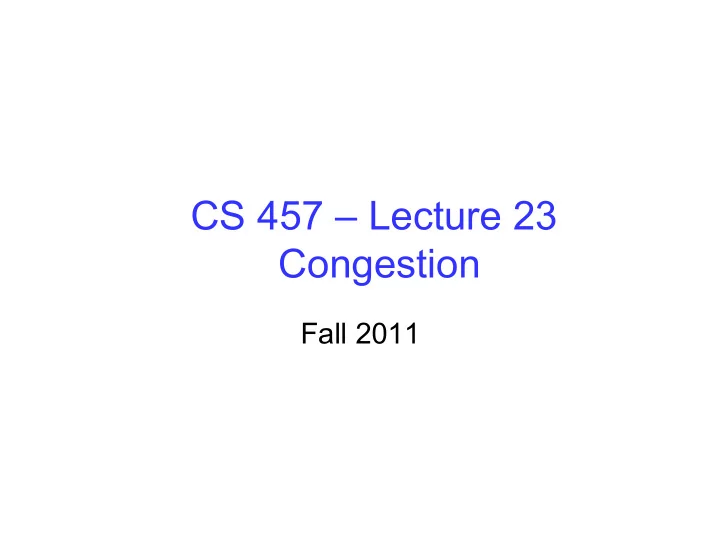

CS 457 – Lecture 23 Congestion Fall 2011
Defining Fairness: MaxMin • Given a resource utotal and several requests pi • Assign allocations of ui to node i. • Allocation is fair if – No one receives more than they requested: ui <= pi for all i – No other allocation has higher minimum allocation (for allocations meeting requirement above) – Recursive true after removal of minimum node: let j = user with minimum allocation let utotal = utotal - uj remove user j above conditions should still hold
A Simple (Incorrect) Approach • Allocate buffer space for each flow – Only drop packet if individual flow buffer overflows – Seems fair in terms of buffer allocation…. • Round-Robin Rule for Sending Packets – Transmit packet from queue 1, then queue 2, etc. • Is this approach fair? – What should a sender do to optimize its share of bandwidth? – Answer: Send VERY big packets!
A Simple (Impractical) Approach • Allocate buffer space for each flow – Only drop packet if individual flow buffer overflows – Seems fair in terms of buffer allocation…. • Round-Robin Rule for Sending Bits – Transmit one bit from queue 1, then queue 2, etc. • Is this approach fair? • Some notation: R(t) = the number of rounds up to time t Nac(t) = the number of active flows at time t S(i,a) = the time packet i from flow a arrives F(i,a) = the time packet i from flow a left
Notations • Some notation: R(t) = the number of rounds up to time t Nac(t) = the number of active flows at time t S(i,a) = the round packet i from flow starts F(i,a) = the round packet i from flow finishes • In which round is a packet transmitted? S(i,a) = Max(R(arrival_time), F(i-1,a)) F(i,a) = S(i,a) + P • Can order packets by their finishing time F(i,a)
A Fair Queuing Algorithm • Important factor is the finishing time F(i,a) – Packet arrived bit by bit (impractical approach) – But it does not matter how bits arrived – Packet is not available until F(i,a) anyway • Fair Queuing Approach – Send packet with lowest F(i,a) • Pre-emption – What if packet arrives with lower F(i,a) then current packet? – Could choose to pre-empt (easier to analyze) or wait (easier to implement)
Simple Congestion Detection • Packet loss – Packet gets dropped along the way • Packet delay – Packet experiences high delay • How does TCP sender learn these? – Loss • Timeout • Triple-duplicate acknowledgment – Delay • Round-trip time estimate
Simple Congestion Detection • Packet loss – Packet gets dropped along the way • Packet delay – Packet experiences high delay • How does TCP sender learn these? – Loss • Timeout • Triple-duplicate acknowledgment – Delay • Round-trip time estimate
TCP Congestion Control Basics • Each source determines available capacity – … and how many packets is allowed to have in transit • Congestion window – Maximum # of unack’ed bytes allowed to be in transit (the congestion-control equivalent of receiver window) – MaxWindow = min{congestion window, receiver window} - send at the rate of the slowest component • How to adapt the congestion window? – Decrease upon losing a packet: back-off – Increase upon success: explore new capacity
Additive Increase, Multiplicative Decrease • How much to increase and decrease? – Increase linearly, decrease multiplicatively – A necessary condition for stability of TCP – Consequences of oversized window are much worse than having an under-sized window • Oversized window: packets dropped, retransmitted, pain for all • Undersized window: lower throughput for one flow • Multiplicative decrease – On loss of packet, divide congestion window in half • Additive increase – On success for last window of data, increase linearly, adding one MSS per RTT
TCP “Sawtooth” Behavior Window Loss halved t
Practical Details • Congestion window (cwnd) – Represented in bytes, not in packets (Why?) – Packets typically one MSS (Maximum Segment Size) • Increasing the congestion window – Increase by MSS on success for last window of data – In practice, increase a fraction of MSS per received ACK • # packets per window: CWND / MSS • Increment per ACK: MSS * (MSS / CWND) • Decreasing the congestion window – Cut in half, but never below 1 MSS
Getting Started Need to start with a small CWND to avoid overloading the network. Window But, could take a long t time to get started!
“Slow Start” Phase • Start with a small congestion window – Initially, CWND is 1 MSS – So, initial sending rate is MSS/RTT • That could be pretty wasteful – Might be much less than the available bandwidth – Linear increase takes a long time to accelerate • Slow-start phase (but in reality it’s “fast start”) – Sender starts at a slow rate (hence the name) – … but increases the rate exponentially – … until the first loss event
Slow Start in Action Double CWND per round-trip time 1 2 4 8 Src D D D A A D D D D A A A A A Dest
What’s Next • Read Chapter 1, 2, 3, 4.1-4.3, and 5.1-5.2 • Next Lecture Topics from Chapter 6.4 and 6.5 – Congestion Control • Homework – Due Thursday in lecture • Project 3 – Report Any Changes in Your Project Group
Recommend
More recommend